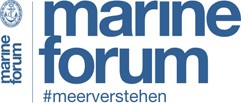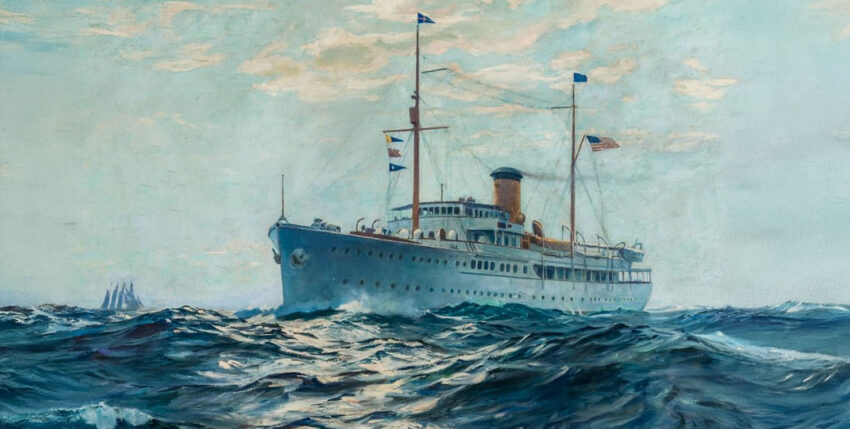Vincent William Astor and Franklin D. Roosevelt steered America through the turbulent first half of the 20th century. Roosevelt as one of the republic's most important politicians and Astor as one of the country's greatest businessmen and philanthropists.
When John Jacob Astor IV died in 1912 when the TITANIC sank, he left his eldest son Vincent an immense fortune that made the junior one of the richest men in the world. He broke off his studies at Havard and used his inheritance responsibly. He renovated the slum-like Astor properties in New York for the tenants, worked with trade unions and donated hospitals and parks. At the same time, he used his leading position in business to security of his country.
When the USA entered the First World War, he volunteered to join the US Navy on Roosevelt's advice. As a lieutenant, he was first assigned to the security of New York harbour and then sent to France on convoy duty. He received his last command and returned to New York on board the captured German submarine U-117 at the end of the war. He did more: he handed over his inherited luxury yacht NOMA to the US Navy. As the USS NOMA SP-131, she escorted allied convoys and hunted German submarines.
After the end of the war, Roosevelt retired from politics to treat his polio. He used the heated swimming pool on the neighbouring property of his friend Astor for this purpose. In the meantime, he had risen to the top of New York society. But his power and influence did not just mean fancy yachts, racing cars or his own aeroplane. Astor supported social reforms and scientific expeditions. When Roosevelt returned to politics and ran for governor of New York, Astor gave him generous financial support for his campaign. This welded the two even closer together.
The Room
Astor was also involved in a hand-picked and influential group of New York bankers, lawyers, diplomats, scientists, defence experts, intelligence officers, reformers and philanthropists. In 1927, they founded a top-secret society called "The ROOM", which met monthly in an anonymous flat in New York City. There, the members reported their observations after returning from their constant world travels. And Astor continuously collected information for the United States government. He used his ultra-modern luxury yacht NOURMAHAL, which he had built at the Germania shipyard in Kiel in 1928, on numerous extended voyages.
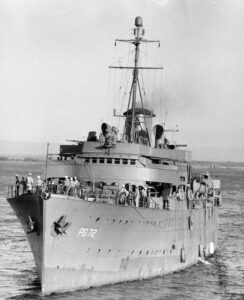
The influence of the CLUB grew when Roosevelt ran for the presidency in 1932. Although he was never a formal member of the ROOM, he knew all the members very well. And on board the NOURMAHAL, he became close comrades with the most influential members of the ROOM - the "NOURMAHAL gang" - on five voyages.
Roosevelt always demanded information. To do so, he sought out trustworthy "agents" who personally passed it on to him. In an increasingly hostile environment with a global economic crisis and emerging dictatorships, he needed secret sources of information outside of official government reports.
And Astor delivered. The earliest information, around 1933, concerned general conditions in the Caribbean and the Panama Canal Zone. In 1936, Roosevelt learned that Astor was planning an expedition for the Charles Darwin Foundation to the Galapagos Islands to investigate rumours that Japanese ships were searching the archipelago for a location for a forward base. But FDR wanted to know even more about what the Japanese were doing on the distant islands in the South Pacific.
In 1938, Astor planned an expedition to the Marshall Islands disguised as a scientific one. He prepared this thoroughly. To access the US Navy's radio network, he obtained a code word for the NOURMAHAL and was also briefed by the Naval Intelligence Service. They wanted to know the locations of the Japanese radio stations. The NOURMAHAL's radio direction finder helped. Although the Japanese refused Astor access to the islands, Astor received a lot of important information from intercepted radio messages and information from British intelligence on the neighbouring islands of Gilbert and Ellis Island. Among other things, he reported that Eniwetok was the main naval base of the Japanese. And finally, he was able to allay Roosevelt's concerns that the Japanese were fortifying the islands.
The Club
After the outbreak of the Second World War, Roosevelt feared that the war could spill over into the western hemisphere and jeopardise American interests. But a vehemently isolationist Senate and restrictive neutrality laws prevented overt measures to protect national security or even prepare for war. He desperately sought ways to circumvent the problem. Astor and the ROOM offered an elegant way out of the dilemma.
Renamed "The CLUB", the work initially focussed on information from the leading New York bank Chase National, which knew the international money flows - including those of the Axis powers - inside out. Of particular interest was the account of AMTORG Bank, a poorly disguised organisation for Soviet espionage in the USA. A sensational coincidence was the Japanese embassy's request to Chase National to send a commission to Japan to investigate the current economic conditions in Japan. So Astor infiltrated agents carefully prepared by the Office of Naval Intelligence (ONI) into the commission.
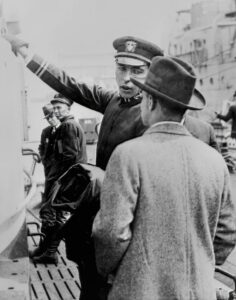
captured German U 117. His
Last commando in the First World War, photo: nal Archives
Roosevelt was particularly interested in information about pro-German activities in the overseas Spanish embassies and espionage efforts against the USA by foreign agents in Mexico City. To this end, Astor, as head of the Western Union Cable Company, had international telephone lines tapped. Although this was forbidden under American law, Astor only informed the president and otherwise kept a tight lid on the matter.
He maintained close contact with employees of the British intelligence services in New York and Bermuda. The Bermuda Censorship Office, for example, helped him to screen diplomatic mail between Europe and the West. And in 1940, he got the British Passport Control Office in New York to provide him and FBI chief Edgar Hoover with information. However, the State Department found out and complained bitterly about the violation of American neutrality. In return, the British government had to stop the flow of information to Astor and Co. But among many other activities, he helped to expose Nazi spies, protect war-related secrets and inform FDR about the activities of Nazi business representatives in the USA.
Area Controller of Intelligence for New York
Although the bureaucrats in the government and military naturally did not like Commander Astor's amateur activities, the State Department, Military Intelligence, Naval Intelligence, FBI and CIA had to contend with overlapping responsibilities, changing activities of the intelligence services and, last but not least, the restrictions imposed by an isolationist Congress. The whole thing was a highly amateurish and inefficient construct.
In 1941, Roosevelt created for Astor the new, unique and secret position of "Area Controller of Intelligence for New York" - the prototype for America's modern intelligence service. This placed Astor in control of all local military intelligence functions; the U.S. Army, the U.S. Navy, the Justice Department and the State Department. With his management experience and strong personality, he was the right man for the job in Roosevelt's eyes.
With the Japanese attack on Pearl Harbor and Hitler's declaration of war, America's coasts were no longer safe from Axis submarines. So Astor took his plan for a "Ships Observer's Scheme", which he had already conceived during the First World War, out of the drawer again. Motor yachts and fishing boats, equipped with radios, were to report sightings of Nazi submarines. Astor also founded the "Civil Air Patrol" with the same tasks. And finally, Astor left his beautiful yacht NOURMAHAL to the U.S. Navy for the symbolic rent of 1,000 dollars per year. For his great services, he was awarded the rank of captain and high honours in 1943.
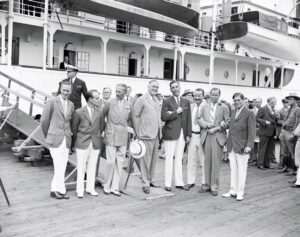
and the "Nourmahal Gang", photo: National Archives
As the war progressed and the secret services became more professionalised, the importance of the area controller slowly diminished. In August 1944, Astor realised that "an Area Controller in New York honestly isn't needed any more" and asked Roosevelt to relieve him of the post. He was drawn back to the navy. There he coordinated convoys and logistics from the Caribbean to the North Atlantic until the end of the war. But he continued to pass on his insider information from Chase National Bank to the White House - not just until the end of the war, but right into the Cold War.
Dr Jürgen Rohweder is a historian and journalist. He was previously Head of Corporate Communications at HDW and Thyssenkrupp Marine Systems.
Jürgen Rohweder
